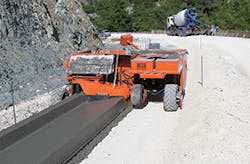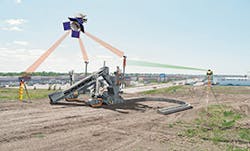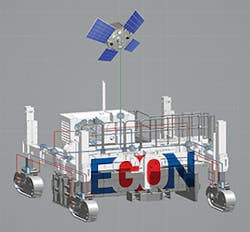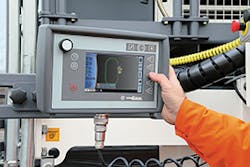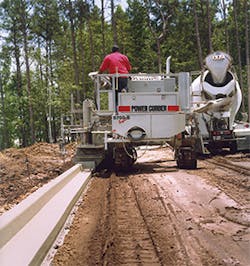We tend to forget that the departments of transportation and project owners are the ones who decide which materials are used for paving, and their decisions in today’s economy are controlled more and more by the durability and likely longevity of the materials used. The cost of roadbuilding is an understandable major consideration in 2014. “Concrete has seen a rise in recent times due to a combination of factors,” observes Dave Lipari at Guntert & Zimmerman (G&Z), a leading maker of paving machines. “Among them are the rise in oil prices, better communication of concrete benefits, a good presentation of life cycle costs, and contractors becoming increasingly skilled at laying down high-quality slabs. The rise in oil prices was probably the first indicating factor as side-by-side project bids (asphalt and concrete) were equalizing in cost.”
“This has led to further analysis of the appropriate material for roadbuilding that does not hinge so greatly on initial cost,” continues Lipari. “Organizations like ACPA and PCA have been steadfast in communicating the benefits of concrete as well as stating the life cycle costs, the benefits of lower maintenance costs and intervals, and longer pavement life. This means nothing if the contractors do not lay down great slabs. Contractors around the country have been encouraged and offered incentives to lay down smooth, quiet slabs, and that has led to concrete gaining significantly in the preferred column of pavement material choice.”
For equipment manufacturers, this has meant focusing on designing systems that reduce downtime and increase paving opportunity. “For G&Z,” explains Lipari, “this means our part to play is supporting the contractors in every way we can, to make their job sites run as smoothly as possible-pun intended! We must supply rigid and precise machines that will offer the contractors the best chance to lay down great slabs. We’ve also focused on making contractors as productive as possible. What we’re seeing in the market is a tightening up of schedules which does not allow for two- or three-day width changes, time-consuming job-site moves, or even inter-job-site equipment moves.”
Changes in the cement itself and how slabs are linked and strengthened have helped make concrete repair, rehabilitation, and resurfacing more favored. It’s more than 30 years since dowels have been used to strengthen slabs, and one interesting and promising technique is the retrofitting of dowels in concrete highways. The dowels, used where heavy loading is expected, are often 18-inch-long steel bars. They bridge the joint sawed between pavement slabs and help to transfer traffic loads from one concrete slab to the next. The new retrofitting technique involves cutting slots across the pavement joints, inserting new bars, and patching the slots with fast-track concrete mixes. The contractor diamond grinds the road to obtain a smooth surface. In the State of Washington, the first to undertake dowel retrofitting on a large scale, the DOT expects the technique will extend the life of some of the state’s 30-year-old concrete highways by 10 to 15 years.
Fast-track concrete mixes were mentioned in the previous paragraph. It’s not that new but you may not be familiar with its advantages. It has been successful especially in reconstructed roads. Where conventional concrete mixes can take from five to 14 days to cure, fast-track concrete can meet the requirements for opening the road again in 12 hours or fewer. While mixes vary for different reasons from state to state, the technical side of fast-track concrete is that this contains a higher proportion of the standard Type I cement to water or it contains high early strength cement, known as Type III. Type III cement particles are ground much smaller than those in Type I, and those smaller cement particles increase the surface area, allowing more cement contact with the water in the concrete mix. That means faster hydration.
Advances in Concrete Paving Equipment
There is some excellent paving equipment available, suitable for projects of all sizes, but all this equipment has one common need. It must be operated correctly, and the crews working with it must be properly trained. A few years ago, the brother of a friend of mine bought a beautiful, expensive, new dozer, and he tipped it down a slope and nearly killed himself on its first run. There was nothing wrong with the machine. The man operating it didn’t bother to learn anything about it. After all, he knew everything there was to know about any construction machine and what could be new about a dozer, huh? It’s the same with concrete paving machines. They have improved enormously in the last decade or so, but the operator must know how to use them correctly and safely, or their purchase and improvements have been a waste of money.
Just one year ago, Gomaco introduced a paver that was not for interstates and highways. We tend to ignore the thousands of paving situations which could be considered small and assume that all paving is for miles of well-traveled, major roads. Gomaco, global leader in concrete paving equipment for long stretches of streets and highways, introduced the GT-3200 sidewalk paver. Not surprisingly, it was a contractor who suggested the innovation. The GT-3200 has an adjustable aggregate base mold on the front and a sidewalk paving mold on the rear. It’s a three-track paver, designed for zero-clearance rehabilitation of sidewalks. During the first pass of the front-mounted adjustable base mold, rock is placed on grade and an auger spreads the material, while three pan vibrators mounted to the mold start the compaction process. The base mold has two heavy-duty hydraulic cylinders that give 14 inches of hydraulic lift for setting the grade depth below the track line and raising the mold for the paving pass.
During the second paving pass, the crew slipforms the sidewalk with a unique, minimum-clearance trailing mold. The GT-3200 sidewalk paver has a 20-inch-wide, 14-foot-long folding conveyor, which allows mix trucks to discharge their material from the street instead of driving over existing curb to reach the paver. The pivoting conveyor (hydraulic) is designed to rotate 180 degrees to allow simple loading of concrete into the hopper from either side of the machine. That also avoids obstacles usually associated with zero-clearance paving. If project specifications require it, the sidewalk mold can have a bar inserter for placing transverse bars into the slab. Gomaco’s sidewalk paver has all-track steering, to save time getting on and off stringline, and to give better onsite mobility and ease of loading and unloading. (You don’t have to remove either the front-mounted adjustable aggregate base mold or the rear-mounted sidewalk paving mold for transportation.) This paver for those frequent sidewalk projects also has G+, Gomaco’s machine-control system for paving accuracy and electronic monitoring of steering and grade.
A company that has long-standing praise for its lighter construction equipment and utility products is MBW. The company also makes a small slipform paver, designed and used for those tight-radius projects with curbs and gutters, such as you find in parking lots, tourist centers, new housing developments, and similar public-use spaces where good order is required in the parking of vehicles. Much smaller than average paving machines, and much less expensive, MBW slipform pavers fill a niche in concrete paving much appreciated by their owners. There are three models. The two-wheel drive C101 pours to a height of 18 inches and a width of 12 inches. The C101-18 (also two-wheel drive) pours to a height of 18 inches and a width of 18 inches. The largest model, the CG200, is three-wheel drive, and pours to 18 inches high with a width up to 48 inches. Production rates will vary, depending on mix, grade, and crew proficiency, but a typical day’s pour would be 1,000 to 1,500 feet of curb and gutter. Two-wheel drive is for curbs; three-wheel drive is for curb and gutter. MBW offers a hopper system that lets users switch pouring modes from offset (for curb only) to “between centers” (for curb and gutter, valley ribbon, etc.) in minutes. Crew size? Three to five people. Transportation? The MBW slipform paver can be carried by pickup and trailer.
How do you get the accurate results you want with those tight shapes in concrete curbs and gutters? Wirtgen offers a 3D control system to be used with its SP 15 and SP 25 slipform pavers. It’s called the Wirtgen AutoPilot and is a GPS-based system that guarantees the highest precision (whether the path is straight or complex curves). It can cope well with paving at radii as small as 2 feet, without stringlines. “It pays off quickly and opens up new fields of applications” says the company. The programming of the profile path or profile configuration is completed onsite, so you don’t have to establish a digital terrain model beforehand. The Wirtgen AutoPilot automatically negotiates any obstacles on the construction site, such as manhole covers. Programming the system takes a matter of minutes. Such control systems are worth investigation because of the time (and money) they save; check with your favorite manufacturer to see what is available.
Technology like this AutoPilot from Wirtgen has improved accuracy everywhere.
In similar vein, you could look at EGON from G&Z. The initials stand for Equipment Guidance and Operation Network and are further proof that technologies are playing major roles in the development of efficient paving equipment. EGON is available on all G&Z slipform paving equipment models. The EGON display (mounted where it suits the operator best) gives an all-in-one overview of the paver’s extensive systems, including status of all machine inputs and outputs (I and O), system faults, electronic monitoring of all hydraulic pump pressures and filter conditions, fuel level, individual forward/reverse track pressure, plus the machine’s configuration and mode. EGON also allows the operator to modify such important machine settings as paver dimensions, gain values, sensor calibration, adjustments for crown and slope, and changes in machine travel modes.
Bridges and Other Projects
Sidewalks are small, contrasted with interstates, but there’s another huge problem in our nation that is road-related. Bridges! The number of bridges requiring repair, resurfacing, rehabilitation, re-everything is in the thousands. For more than 50 years, when contractors talk about concreting bridges, they have mentioned Bid-Well (a division of Terex Roadbuilding). Terex Bid-Well offers three sizes of roller pavers. The 2450 has a truss size of 24 feet, a maximum paving width of 56 feet, and a standard operating weight of just over 6,000 pounds. The 3600, with a truss size of 36 inches, offers a maximum paving width of 86 feet, and weighs 7,760 pounds. The largest model, the 4800, has a truss size of 48 inches, paves up to 116 feet wide, and weighs 10,473 pounds. (Just a note here on those weights: the largest Bid-Well roller paver weighs 7,760 pounds and can pave up to 116 feet of bridge. That’s about half of what a medium-size wheel loader weighs.) These pavers have all-welded steel construction for strength and minimum weight and each model offers automatic machine operation with the patented Rota-Vibe system for achieving more uniform concrete surface with the desired density. A traveling carriage strikes off, paves, and textures the concrete with augers, paving rollers, a drag pan, and texturing.
On every pass, the roller pavers have adjustable dual augers that strike off and meter excess concrete forward; that will give higher production and mean reduced labor for the contractor. Another
EGON from Guntert & Zimmerman is another technological advance. This is an artist’s impression of it at work.
enhancement for productivity is the way the roller pavers move forward automatically to position the paving rollers for the next paving pass. Because all bridges are not the same and all local regulations and specs may demand different designs, the two larger models of these bridge pavers (the 3600 and the 4800) are designed and equipped to pave a variety of surfaces, including flat, crowned, parabolic, skewed, super-elevated, and tapered. It doesn’t take much study of brochures and specifications to see why Terex Bid-Well is a name that has been in the front of makers of such specialized paving machines as those for bridges, canals, slopes, airports, and overlays. If you consider bridge contracts, you should also consider that Terex Bid-Well, a few years ago, introduced an automated sidewalk roller that is attached to the carriage roller frame of either a 3600 or 4800 bridge paver. This allows the contractor to pave the bridge deck and walkway at the same time. A three-tier frame hanging system gives you flexible positioning of the unit. You don’t need a separate engine because the hydraulically powered sidewalk roller paver uses oil from an 8-gallon pump driven by the same system as the main machine. The operator of the paver controls oil flow to the sidewalk attachment and two levers at the assembly control rotation and the forward/reverse movement of the 6-inch-diameter roller. It’s a practical improvement that saves all kinds of time and labor.
Adjusting to the Special Project
As far as most drivers are concerned, placing concrete is one of those jobs that has to be done, and why can’t they do it when I’m not using that stretch of road? This attitude of the paying travelers, plus some considerations for everybody’s safety, can add special conditions to a project, and to the decisions about equipment. On a $64 million Interstate project in Columbia, SC, due to new development on the east side of the city, the South Carolina DOT decided to widen Interstate 20 from two lanes to three for a 6-mile stretch near Interstate 77. Zachry Construction Corp. planned to pave an inside lane and shoulder in an 18-foot-wide slab on each side of the four-lane divided highway. Then, in a multistage process, the contractor removes the existing east-bound and west-bound lanes and paves two new lanes at 24 feet wide on each side. That is not at all straightforward, and originally Zachry had planned to pave the I-20 at 34 feet wide.
To accomplish a not-so-simple-task Zachry decided to buy a Guntert & Zimmerman machine, the new paver (S850 SL) equipped with both a G&Z CDBI (compact dowel bar inserter) and the Leica PaveSmart 3D stringless machine-control system. “Joint spacing is 15 feet for this I-20 project, and the Guntert DBI places the dowel bars right on the money,” comments Mark Fancella, Zachry’s paving superintendent for the job. “I used to be a firm believer in a competitive paver but now I’m a Guntert man! I like the side forms on it. You can move them in and move them out. And I like the swing legs. The place we’re paving now is in really tight quarters. We only had 3 feet on one side, paving up against a median barrier. We just tucked the legs in and had no problems.” The S850-SL was paving concrete 12 inches thick and 18 feet wide. Last spring the production rate was running between 200 and 350 cubic yards of concrete per hour, or between 3,500 and 4,000 feet per day.
The Leica PaveSmart 3D system allows stringless paving. Zachry bosses said it took about a week for their new crews to learn the Leica system; its uses three robotic total stations, with two active at any time. The Leica system regulated the steering, grade, draft, and crossfall of the paver with no need for the contractor to retrofit complex hydraulics. The Leica PaveSmart 3D guides the concrete paver in relation to a digitized 3D model of the highway, operating on the machine computer onboard the paver. This works best, according to an experienced paving man, if you set up the total stations 250 feet in front of the paver. As the machine passes a station, the crew moves the station (now in the rear) to its new forward position. It’s like leapfrogging the total stations and the paver never has to stop. Every contractor who has ever paved knows the advantages of never having to stop the paver. No bumps! No extra work! It’s essential that you use an accurate digital model for stringless work and that you calibrate the paver correctly.
Let’s put in a short paragraph here on the advantages of stringless paving, for those who have not invested in it, or researched it, so far. The payback for purchase of the system is quick. You have far less surveying and staking to do, and it’s safer. Nobody is going to worry about injuries or unexpected costs caused by somebody tripping over a stringline. You don’t need to worry about costly errors caused by breaking a stringline. You can back trucks right in front of the paver without worrying about interference with a stringline. Stringless paving brings savings of all kinds.
Fully Automatic 3D Wirtgen launches a pioneering 3D control system for use with the SP 15 and SP 25 slipform pavers. The Wirtgen AutoPioletis a user friendly, cost-effective machine-control system for the construction of poured-in-place concrete profiles, such as curbs or safety barriers, in offset application. The GPS connection provides high precision and efficiency, regardless of whether straight profiles, highly complex curved profile paths, or even closed-profile configurations have to be paved. The AutoPiolet enables fully automatic paving at extremely small radii of merely 600 mm or 2 feet. Establishing a digital terrain model is not required, as programming of the profile path or profile configuration is completed onsite. The AutoPiolet also automattically negotiates any obstacles on the construction site, such as manhole covers.The system comprises a computer integrated in the machine as well as a control panel that allows intuitive operation. Two GPS receivers, which are mounted on masts on the machine, communicate with an additional GPS reference station positioned onsite. The system can be programmed in a matter of minutes:
- The machine operator selects a profile configuration at the control panel.
- He enters length, width, and radius of the configuration to establish the steering path of the slipform paver.
- The operator establishes the starting point.
- The machine level and elevation profile is established.
- The machine operator determines the cross slope. A laser sensor or ultrasonic sensor mounted on the slipform paver scans the ground surface to ensure precise level control.
- The fully automatic paving operation commences.
More on Special Projects
Power Curbers earned its name and good reputation for the curb, gutter, and barrier projects that its crews completed. The company was established 60 years ago and, in 2002, started a sister company called Power Pavers, which contracts to do the more usual type of project. Its machinery is working in more than 80 countries worldwide. The most popular paver from Power Pavers is the SF-2700 slipform paver, with two heavy-duty 12-foot track systems. Paving speeds go from 0 to 30 fpm and travel speed from 0 to 60 fpm. The side clearance (the distance from the edge of the slab to the outermost part of the track) is 29 inches, with standard two-speed motors.
The paving depth of the SF-2700 can be from 0 to 16 inches and the paving width ranges from 12 feet to 27 feet. There is an optional paving width to 32 feet and an overall width that is 58 inches wider than the paving width. Paving length is 14 feet, 5 inches. The weight of this competent machine varies from 40,000 pounds to 46,000 pounds. For transportation, the width (when assembled) is 12 feet; with the tracks off, the width is 8 feet, 6 inches. Height is also 8 feet, 6 inches and the length is 58 inches longer than the paving width. Grade control can be manual or automatic and the operator has the options of manual or automatic steering control, with counter rotation of the crawler tracks in the manual mode. The hydraulic strike-off is controlled by the operator for metering concrete flow to the enclosed vibrator and tamper section in front of the profile pan.
Today’s Claims for Concrete Roads
Let’s revisit the claims made for concrete roads, claims that seem more confident each time we consider them. Let’s also remember that, whether you’re taking about concrete or any other materials for roads, the key is still in the efficient placing of those materials. Good results are personal, dependent on the contractor and his crew as much as on the equipment and materials chosen. Each year, we see more and more communities (with justification) bemoaning the lack of funds for road rehabilitation, repair, and building. Costs have risen steadily, and will probably continue to do so, while funds available for such vital (but, apparently, unexciting) projects as improving the failing infrastructure of our country seem to float away in schemes whose benefits are often hard to describe. This economic state of affairs means that the cost of roads is of increasing importance. It’s not just that initial cost, but the longer and greater cost of maintaining roads.
Power Curbers has earned its name and good reputation from the many curb, gutter, and barrier projects that its crews have completed.
Many benefits of using concrete for roads may not be obvious when the first decisions are being discussed and made. The durability of concrete roads is seldom challenged, the fact that they last years longer than competitive types, but what hidden savings are involved in that simple concept? Because of their strength, concrete roads require less maintenance and repair than, say, asphalt roads. How much, over the years, will that save your community? If your community is one that suffers from winter attacks of snow, ice, and general freezing, you will understand how much better it is to have a road that will resist the gouging of our replies to bad weather: chains and snow tires.
You could also consider that concrete roads tend to hold their shape well, which means they resist skids better and produce fewer potholes. All my neighbors wish we had streets that didn’t seem to accumulate more potholes each winter, because potholes can be expensive for vehicle owners. There is also the question of safety. One neighbor, whose nephew was in a serious accident caused by potholes in non-concrete streets, tells me roads that are strong enough to resist potholing can actually save lives.
There are other, not so obvious advantages to concrete roads, and they can all save money in amounts worthwhile to any community. Concrete tends to reflect light and that can mean less expense in lighting; it can also lower the actual temperature in a community in those hot, summer months.
As communities and their public works departments, which try to serve their infrastructure needs as well as funds allow, fight to keep up with the natural demands of all deteriorating aspects of our national infrastructure, the life cycle of new equipment and projects takes on a leading role.
Purchase of any equipment, product, or service is not only its initial cost, but also it’s the cost of maintenance, of sustainability, of reliable usefulness. The cost of ownership of a road is another of those challenges, similar to the cost of ownership of personal items like vehicles and appliances, that must be considered seriously at the outset. For roads, concrete is beginning to look most appealing…again.